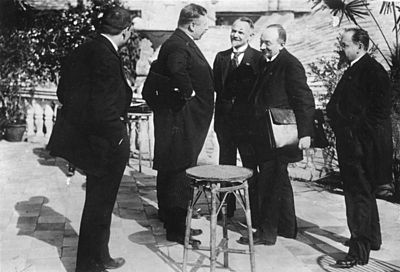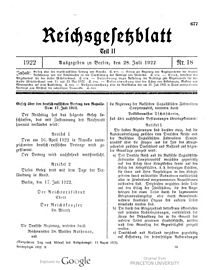Rapallo Treaty

The Treaty of Rapallo is a treaty under international law that was concluded on April 16, 1922, an Easter Sunday, in Rapallo , Italy, between the German Reich and the Russian Soviet Socialist Federal Republic (later founding member of the Soviet Union ). The surprising conclusion of the contract took place on the sidelines of the Genoa financial and economic conference. The contract was signed by the German Foreign Minister Walther Rathenau and his Soviet Russian counterpart Georgi Tschitscherin . The treaty normalized the relations between the two states, which wanted to break through their respective international isolation with it, and was intended to strengthen the negotiating position of the German Reich against the Western powers . With Germany, whose guilt for the outbreak of the First World War the Peace of Versailles had established, and the socialist Russia, two outlaws of the international politics of the time united. It came into force immediately upon signature.
Content of the contract

The main content of the treaty was that the German Reich and Soviet Russia would resume their diplomatic and economic relations, which had been interrupted by the war and the Russian Revolution , according to the principle of most-favored-nation treatment . The latter was important for the German Reich because its goods were still boycotted by the former war opponents in Western Europe . Furthermore, both states waived reparations for war damage, and the German Reich also waived compensation for formerly German property that was nationalized in the course of the revolution.
In the context of the contract, the delivery of industrial plants to Soviet Russia was agreed, through which it could have operated the Baku oil fields without the support of Western companies. In addition, the German Reich committed itself to set up storage facilities and filling stations for the marketing of Russian oil products. In this way, the German Empire planned to reduce its dependence on the British and American oil cartels that dominated the market.
Military aspects
Contrary to the widespread assumption to date, the treaty did not contain a secret additional military protocol, but a secret military cooperation had already begun, which has now been contractually agreed. It was stated in a lapidary manner in Article 5 that “the German government declares its readiness to support the agreements that it has recently communicated and intended by private companies and to facilitate their implementation” . This established practice of agreements under private law should not compromise the Reich government , especially with regard to the provisions of the Versailles Treaty , although the running costs of the maintenance of the individual projects were paid from the budget of the Reichswehr Ministry. For example, the Junkers factories opened an aircraft factory in Fili near Moscow , a flight school and air force test base in Lipetsk , a test and development site for poison gas in Tomka, and a training base for tank officers and a tank training area in Kazan. Soviet Russia and later the Soviet Union received in part modern weapon technology. This offered the Reichswehr the opportunity to train their soldiers there on weapons that the German Reich was not allowed to possess under the Versailles Treaty. Military cooperation was an important basis for building up German air forces, which was strictly forbidden under the provisions of the Versailles Treaty. A secret flying school and test site of the Reichswehr was established near the Russian city of Lipetsk from 1925 and operated until September 1933. Around 120 German pilots, 100 aerial observers and numerous ground personnel were trained there and, on a small scale, newly developed aircraft designs were tested in Germany. Overall, this school, officially designated by the Soviets as the 4th Aviation Department of the 40th Squadron of the Red Army , used a number of Dutch, Soviet and German aircraft.
Reactions
In the German Reich, the agreement was welcomed by a majority, but also met with resistance, for example from President Friedrich Ebert and the other social democratic leadership; Rathenau too had previously refused Russian requests for a contract and was hesitant to the end.
Nationalist communists and socialist-oriented forces in the Volkish camp (as well as the temporary alliance of both currents in the domestic struggle against Weimar and in the foreign policy desire for German-Soviet Russian cooperation) welcomed the anti-Western treaty. In the German national and right-wing extremist camp, rapprochement with Bolshevik Russia was rejected and Rathenau, who was hated there because of his Jewish descent, was blamed. Walther Rathenau was murdered on June 24, 1922, a few months after signing the contract, by members of the right-wing extremist organization Consul .
As the only party leader of the right-wing oppositional parties, Hitler considered the Rapallo Treaty to be completely wrong.
The Western powers, especially France , opposed the treaty because it strengthened the outsiders Germany and Soviet Russia and reduced the dependence of the German Empire on the Western powers. Two days after the treaty was signed, they protested through diplomatic channels. They suspected that the two states were planning a new division of Poland , which had been re-established as a state in the Treaty of Versailles. This assumption was not completely unfounded: The Reichswehr under General Hans von Seeckt was actually planning a revision of the eastern border.
The Treaty of Rapallo helped France to use a slight shortfall of the reparations payments prescribed in the Treaty of Versailles as a pretext for occupying the Ruhr in 1923.
To this day one speaks of the “Rapallo Complex” when one means the distrust that arises in the countries of the western hemisphere as soon as Germany moves too much towards Russia. This complex was last invoked when the Schröder government was assigned a “Paris-Berlin-Moscow” axis, but also in connection with Konrad Adenauer's trip to Moscow in 1955 and Willy Brandt's Ostpolitik after 1970, this fear of a repetition of the events of 1922 played out a major role.
Place of conclusion of the contract
In 1928, part of the municipality of Rapallo was assigned to the neighboring municipality of Santa Margherita Ligure by royal decree . As a result, the Imperiale Palace Hotel, in which the Soviet Russian delegation of the Genoa Conference stayed and in which the treaty was negotiated and signed, is no longer in Rapallo, but in Santa Margherita Ligure. The hotel management has been given the room where the contract was signed for viewing; Copies of the contract are posted on the walls. One of the curiosities is that the German delegation met for a legendary "pajama conference" the night before the signing of the contract, after the last Soviet proposals were received, in order to coordinate again before signing the contract.
See also
- From the German side, the Moscow Treaty was regarded as the execution contract for Rapallo in 1925 .
- The next stage in German-Soviet relations was the 1926 Berlin Treaty .
- The German Reich signed the Locarno Treaties with the West in 1925 .
literature
- Wipert von Blücher : Germany's way to Rapallo. Memories of a man from the second rank . Limes Verlag, Wiesbaden 1951.
- Helmuth KG Rönnefahrt, Heinrich Euler: Conferences and contracts. Contract Ploetz. Handbook of Historically Significant Meetings and Agreements. Part II. Volume 4: Latest Times, 1914–1959. 2nd expanded and changed edition. Ploetz Verlag, Würzburg 1959, pp. 71-74.
- Alfred Anderle : The German Rapallo Policy. German-Soviet relations 1922–1929 . Rütten & Loening, Berlin 1962. (= publications of the Institute for the History of the Peoples of the USSR at the Martin Luther University Halle-Wittenberg 4) Table of contents ( Memento from March 25, 2016 in the Internet Archive )
- Sebastian Haffner : The Devil's Pact. 50 years of German-Russian relations . Rowohlt, Reinbek near Hamburg 1968.
- Eva Ingeborg Fleischhauer : Rathenau in Rapallo. A necessary correction of the state of research . In: Vierteljahrshefte für Zeitgeschichte, issue 3/2006, p. 365 ff. ( Online )
Web links
- The German-Russian Treaty (Rapallo Treaty), April 16, 1922 , in: 1000dokumente.de
- German-Russian Treaty of Rapallo (The text of the contract on documentArchiv.de) (Reichs-Gesetzblatt 1922 II, pp. 677–679.)
- Rapallo's contract with the DHM
- Website of the Walther Rathenau Society in Rapallo ( Memento from August 8, 2007 in the Internet Archive )
- Hotel Imperiale with “Treaty Room”
Individual evidence
- ^ Reichsgesetzblatt, Part II, No. 18, 1922 of July 28, 1922, p. 92.
- ↑ Florian Peter Kleeberg, Organization and Nature of the Imperial Army of the Weimar Republic, GRIn Verlag Munich 2010, ISBN 978-3-640-77182-0 , p. 44ff.
- ↑ Rolf-Dieter Müller : The enemy is in the east: Hitler's secret plans for a war against the Soviet Union in 1939 . Ch. Links Verlag, Berlin 2011, p. 268 ( online ).
- ^ Heinrich August Winkler : The long way to the west , Vol. 1: German history from the end of the Old Empire to the fall of the Weimar Republic . CH Beck, Munich 2000, p. 423.
- ↑ Regio decreto-legge No. 2079 of August 10, 1928
- ↑ Nuovi confini tra Rapallo e Santa Margherita Ligure ( memorial from January 22, 2016 in the web archive archive.today ), La Gazzetta di Santa
- ^ History , Imperiale Palace Hotel